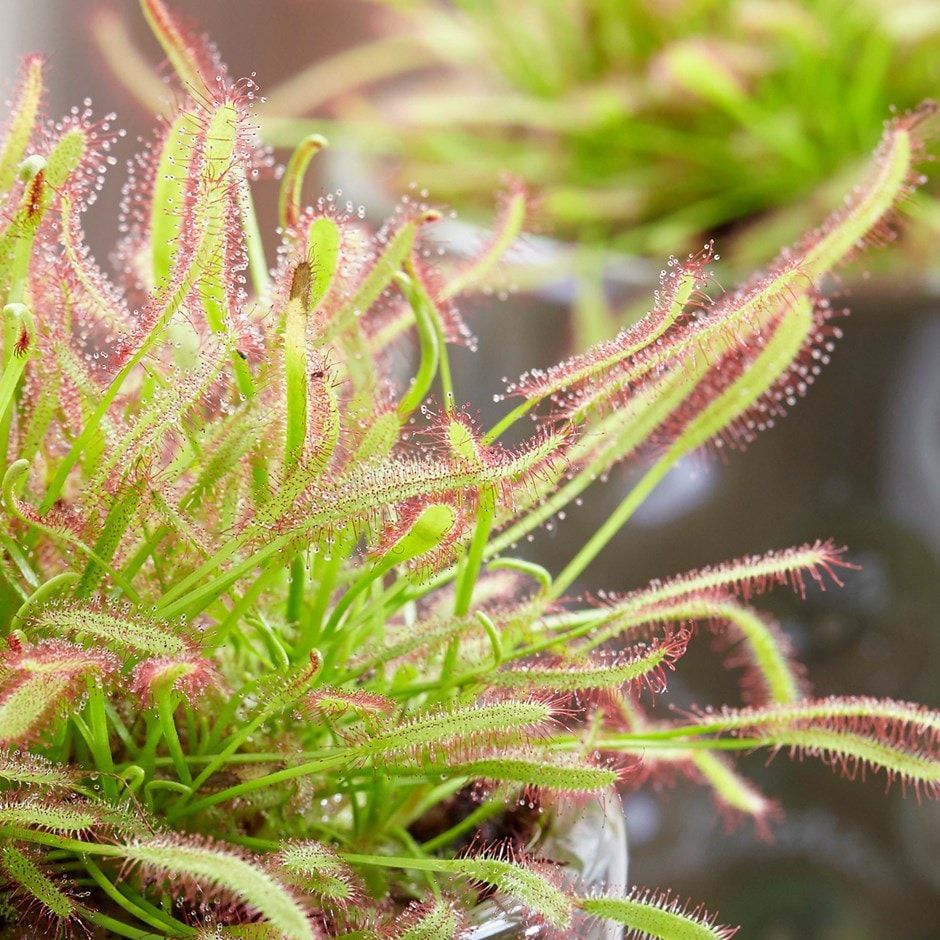
Drosera capensis x spatulata for Sale. Grow Carnivorous Plants!
Also known as a white Cape Sundew, the Capensis Alba is the albino version of. Drosera Capensis. Cape Sundews get their distinctive red coloring from anthocyanin, which. the Alba lacks: Both the dew-tipped tentacles and its flowers are white. Your white Cape. Sundew needs the same growing conditions as its red twin, and many plant growers enjoy.

Buy Cape sundew Drosera capensis
Sundews, or Drosera, are beautiful & deadly carnivorous plants that lure insects with glistening dewdrops. Each of 200+ species of sundew has a unique beauty, and some even move. Many sundews are easy for the beginner to care for, so if you're a new grower, consider starting with a sticky friend like Drosera capensis.

DROSERA capensis 9cm Evergreens Turn It Tropical
Drosera capensis or Cape Sundews is the most popular drosera variant. It is a beautiful carnivorous plant and also happens to be one of the easiest to grow. If you are interested in caring for drosera capensis, this guide explains everything you need to get started.
Drosera capensis 'Typical' Cape Sundew Curious Plant
Height: 2" - 6" Plant Type: Perennial, tropical Soil: Lower Bog Mix or General CP Mix Light: Bright indoors, full sun to partial sun outdoors Use: Grows well in the protected bog garden, greenhouse and indoors. It is an excellent terrarium plant

Drosera capensis ‘Alba’ 25s, Carnivorous Plant Sundew Seeds Little Green Monsters
Description Drosera capensis is a free-flowering, robust, carnivorous, evergreen perennial, of varying height, but usually around 150 mm. The short, woody stems are rhizomatous below with well-developed roots. The leaves radiate from the stem and are made up of a petiole and lamina, the petiole being almost the same length as the lamina.

Drosera capensis, Broad Leaf
Water your sundews as you would normally do with other carnivorous plants. Place the pot with the plant in the tray with water filled to about 0.5-1 inch. Keep the soil only damp to slightly dry when plants enter the dormancy state. Only use distilled, reverse osmosis, purified, demineralized or rain water.

Drosera capensis red (Cape Sundew) for sale Carnivorous Plant Resource
Despite its rather gentle sounding name, the sundew, also known as Drosera capensis, is a carnivorous plant. It belongs to one of the largest genera of carnivorous plants, with over 90 separate species. These species feature many sub-species as well and they have descriptive names like King Sundews, Temperate Sundews, Rosetted Sundews, etc.

Drosera capensis red (Cape Sundew) for sale Carnivorous Plant Resource
In conclusion, Drosera Capensis, the Cape sundew, is not only a delightful and captivating addition to your plant collection but also an excellent choice for beginners in the world of carnivorous plants. Its unique characteristics, including its efficient prey-catching mechanisms, make it a fascinating plant to observe and care for.

Drosera capensis 'Big Pink', live carnivorous plant, potted Blue Ridge Exotics
Drosera capensis (the Cape Sundew) is the most common sundew in cultivation, since it is so easy to grow (once it is given favorable conditions). Drosera capensis originates from the subtropical Cape region of South Africa. Drosera capensis is commonly known to become a weed in sundew collections because the tall flower stalks produce copious.

Drosera capensis Door Jan Meijvogel Bog Plants, Cactus Plants, Garden Plants, Carrion Flower
Description Drosera capensis is a carnivorous plant known for its sticky, glandular tentacles that capture and digest insects. It has ornamental value due to its unique appearance and insect-trapping abilities. It is not known to have significant commercial value, nor is it considered invasive or problematic in most regions. Size

Drosera capensis 'Wide Leaf' Cape Sundew Curious Plant
The plant gets its name from the glistening drops of mucilage on its leaves, which resemble morning dew. The leaves of the Octopus Plant are long and slender, with a reddish tinge at the base and a greenish-yellow color toward the tip.. One of the most unique characteristics of the Drosera capensis is its ability to trap and digest insects.The plant uses its leaves to produce sweet-smelling.

Macro of my baby drosera capensis SavageGarden
A perennial plant that is native to the Cape of South Africa (hence the name), the cape sundew grows small rosettes and features sticky leaves with vibrantly colored tentacles to lure small bugs and insects. Once its pray lands on the leaves, they're trapped by the sticky substance that it produces.

Drosera capensis 'Typical' Cape Sundew Curious Plant
As the the name suggests, the carnivorous leaves and petioles of a Drosera capensis 'Narrow Leaf' are almost identical to the wide leafed variety, but narrower at about 1/4 inch (6 mm) in diameter. Leaves are green with red gland "hairs.". Leaves frequently fold over or curl around prey to increase contact with an unfortunate insect and.

Tropical Drosera Capensis, Cape Sundew "Typical" Carnivorous Plant Resource
Step 1: Aquiring Your Plant & Substrate Plants Drosera capensis is commonly sold at gardening centers. Usually in small pots filled with dozens of small plants these are usually Drosera capensis 'alba' which are solid light green and don't posess the red hue that the regular Drosera capensis has.

Drosera capensis 'Wide Leaf' Cape Sundew Curious Plant
Drosera capensis, commonly known as the Cape sundew, [1] [2] is a small rosette -forming carnivorous species of perennial [3] sundew native to the Cape in South Africa.

Cape Sundew Plant Drosera capensis Carnivorous Gift Box
Commonly called a 'Cape Sundew', Drosera capensis is a type of carnivorous plant, meaning that it can attract & trap insects, which then breakdown and essentially provide the plant with the fertilizer it needs.Drosera trap their prey with sticky droplets that form on the little hair-like tentacles on their leaves. Once an insect is trapped, the leaves roll up around the insect in order to.